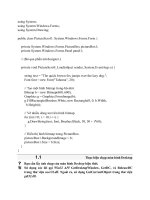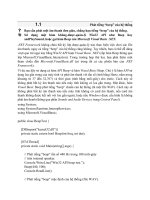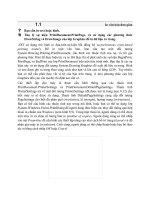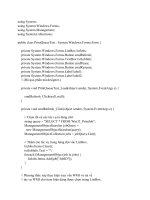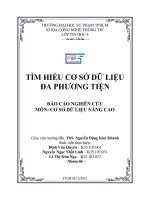slides csdl đa phương tiện
Bạn đang xem bản rút gọn của tài liệu. Xem và tải ngay bản đầy đủ của tài liệu tại đây (5.48 MB, 61 trang )
Multimedia Databases
Wolf-Tilo Balke
Younès Ghammad
Institut für Informationssysteme
Technische Universität Braunschweig
0 Organizational Issues
• Lecture
– 07.04.2016 – 14.07.2016
– 09:45-12:15 (approx. 2 lecture hours with a break)
– Exercises, detours, and homeworks
• 5 Credits
• Exams
– Oral exam
– Achieving more than 50% in
homework points is advised
Multimedia Databases – Wolf-Tilo Balke – Institut für Informationssysteme – TU Braunschweig
2
0 Organizational Issues
• Recommended literature
– Schmitt: Ähnlichkeitssuche in
Multimedia-Datenbanken,
Oldenbourg, 2005
– Steinmetz: Multimedia-Technologie:
Grundlagen, Komponenten und
Systeme, Springer, 1999
Relational Database Systems 1 – Wolf-Tilo Balke – Institut für Informationssysteme – TU Braunschweig
3
0 Organizational Issues
– Castelli/Bergman: Image Databases,
Wiley, 2002
– Khoshafian/Baker: Multimedia and
Imaging Databases, Morgan
Kaufmann, 1996
– Sometimes: original papers (on our Web page)
Relational Database Systems 1 – Wolf-Tilo Balke – Institut für Informationssysteme – TU Braunschweig
4
0 Organizational Issues
• Course Web page
– />– Contains slides, exercises,
related papers and a video
of the lecture
– Any questions? Just drop
us an email…
Relational Database Systems 1 – Wolf-Tilo Balke – Institut für Informationssysteme – TU Braunschweig
5
1 Introduction
1 Introduction
1.1 What are multimedia databases?
1.2 Multimedia database applications
1.3 Evaluation of retrieval techniques
Multimedia Databases– Wolf-Tilo Balke – Institut für Informationssysteme – TU Braunschweig
6
1.1 Multimedia Databases
• What are multimedia databases (MMDB)?
– Databases + multimedia = MMDB
• Key words: databases and multimedia
• We already know databases, so what is
multimedia?
Multimedia Databases– Wolf-Tilo Balke – Institut für Informationssysteme – TU Braunschweig
7
1.1 Basic Definitions
• Multimedia
– The concept of multimedia expresses the
integration of different digital media types
– The integration is usually performed in a document
– Basic media types are text, image, vector graphics,
audio and video
Multimedia Databases– Wolf-Tilo Balke – Institut für Informationssysteme – TU Braunschweig
8
1.1 Data Types
• Text
– Text data, Spreadsheets, E-Mail, …
• Image
– Photos (Bitmaps),Vector graphics, CAD, …
• Audio
– Speech- and music records, annotations, wave files,
MIDI, MP3, …
• Video
– Dynamical image record, frame-sequences,
MPEG, AVI, …
Multimedia Databases– Wolf-Tilo Balke – Institut für Informationssysteme – TU Braunschweig
9
1.1 Documents
• Document types
– Media objects are documents which are of
only one type (not necessarily text)
– Multimedia objects are general documents
which allow an arbitrary combination of
different types
• Multimedia data is transferred through the
use of a medium
Multimedia Databases– Wolf-Tilo Balke – Institut für Informationssysteme – TU Braunschweig
10
1.1 Basic Definitions
• Medium
– A medium is a carrier of information in a
communication connection
– It is independent of the transported information
– The used medium can also be
changed during information
transfer
Multimedia Databases– Wolf-Tilo Balke – Institut für Informationssysteme – TU Braunschweig
11
1.1 Medium Example
• Book
– Communication between author
and reader
– Independent from content
– Hierarchically built on text
and images
– Reading out loud represents
medium change to sound/audio
Multimedia Databases– Wolf-Tilo Balke – Institut für Informationssysteme – TU Braunschweig
12
1.1 Medium Classification
• Based on receiver type
– Visual/optical medium
– Acoustic mediums
– Haptical medium – through tactile senses
– Olfactory medium – through smell
– Gustatory medium – through taste
• Based on time
– Dynamic
– Static
Multimedia Databases– Wolf-Tilo Balke – Institut für Informationssysteme – TU Braunschweig
13
1.1 Multimedia Databases
• We now have seen…
– …what multimedia is
– …and how it is transported (through some
medium)
• But… why do we need databases?
– Most important operations of databases are data
storage and data retrieval
Multimedia Databases– Wolf-Tilo Balke – Institut für Informationssysteme – TU Braunschweig
14
1.1 Multimedia Databases
• Persistent storage of multimedia data, e.g.:
– Text documents
– Vector graphics, CAD
– Images, audio, video
• Content-based retrieval
– Efficient content-based search
– Standardization of meta-data (e. g., MPEG-7, MPEG-21)
Multimedia Databases– Wolf-Tilo Balke – Institut für Informationssysteme – TU Braunschweig
15
1.1 Multimedia Databases
• Stand-alone vs. database storage model?
– Special retrieval functionality as well as corresponding
optimization can be provided in both cases…
– But in the second case we also get the general
advantages of databases
•
•
•
•
•
Declarative query language
Orthogonal combination of the query functionality
Query optimization, Index structures
Transaction management, recovery
...
Multimedia Databases– Wolf-Tilo Balke – Institut für Informationssysteme – TU Braunschweig
16
1.1 Historical Overview
1960
Retrieval procedures for text documents
(Information Retrieval)
1970
Relational Databases and SQL
1980
Presence of multimedia objects intensifies
1990
SQL-92 introduces BLOBs
First Multimedia-Databases
2000
Multimedia Databases– Wolf-Tilo Balke – Institut für Informationssysteme – TU Braunschweig
17
1.1 Commercial Systems
• Relational Databases use the data type BLOB
(binary large object)
– Un-interpreted data
– Retrieval through metadata like e.g., file name, size,
author, …
• Object-relational extensions feature
enhanced retrieval functionality
– Semantic search
– IBM DB2 Extenders, Oracle Cartridges, …
– Integration in DB through UDFs, UDTs, Stored
Procedures, …
Multimedia Databases– Wolf-Tilo Balke – Institut für Informationssysteme – TU Braunschweig
18
1.1 Requirements
• Requirements for multimedia databases
(Christodoulakis, 1985)
– Classical database functionality
– Maintenance of unformatted data
– Consideration of
special storage and
presentation devices
Multimedia Databases– Wolf-Tilo Balke – Institut für Informationssysteme – TU Braunschweig
19
1.1 Requirements
• To comply with these requirements the following
aspects need to be considered
– Software architecture – new or extension of
existing databases?
– Content addressing – identification of the objects
through content-based features
– Performance – improvements using indexes,
optimization, etc.
Multimedia Databases– Wolf-Tilo Balke – Institut für Informationssysteme – TU Braunschweig
20
1.1 Requirements
– User interface – how should the user interact with
the system? Separate structure from content!
– Information extraction – (automatic) generation
of content-based features
– Storage devices – very large storage capacity,
redundancy control and compression
– Information retrieval – integration of some
extended search functionality
Multimedia Databases– Wolf-Tilo Balke – Institut für Informationssysteme – TU Braunschweig
21
1.1 Retrieval
• Retrieval: choosing between data objects.
Based on…
– a SELECT condition (exact match)
– or a defined similarity connection
(best match)
• Retrieval may also cover the
delivery of the results to the user
Multimedia Databases– Wolf-Tilo Balke – Institut für Informationssysteme – TU Braunschweig
22
1.1 Retrieval
• Closer look at the search functionality
– „Semantic“ search functionality
– Orthogonal integration of classical and extended
functionality
– Search does not directly access the media objects
– Extraction, normalization and indexing of contentbased features
– Meaningful similarity/distance measures
Multimedia Databases– Wolf-Tilo Balke – Institut für Informationssysteme – TU Braunschweig
23
1.1 Content-based Retrieval
• “Retrieve all images showing a sunset !”
• What exactly do these images have in common?
Multimedia Databases– Wolf-Tilo Balke – Institut für Informationssysteme – TU Braunschweig
24
1.1 Schematic View
• Usually 2 main steps
– Example: image databases
Image
collection
Digitization
Image analysis
and feature
extraction
Image
database
Creating the database
Querying the database
Image
query
Digitization
Image analysis
and feature
extraction
Similarity
search
Search result
Multimedia Databases– Wolf-Tilo Balke – Institut für Informationssysteme – TU Braunschweig
25


